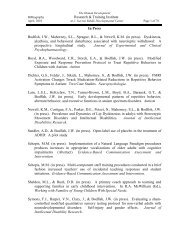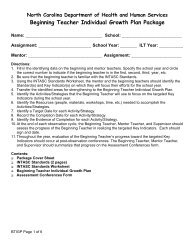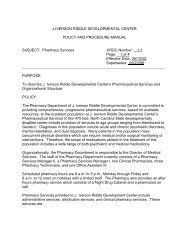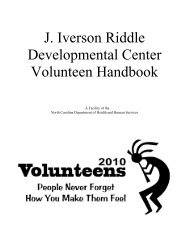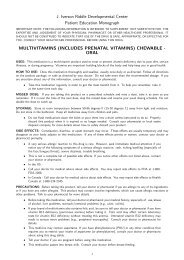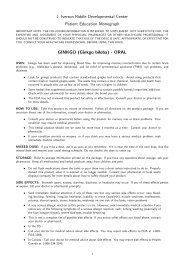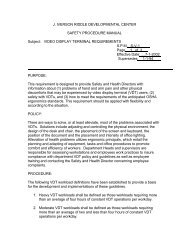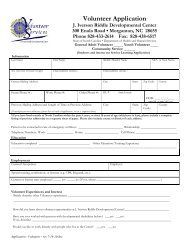Formative Observation Data Analysis (FODA) Teacher Name: _Ima ...
Formative Observation Data Analysis (FODA) Teacher Name: _Ima ...
Formative Observation Data Analysis (FODA) Teacher Name: _Ima ...
- No tags were found...
Create successful ePaper yourself
Turn your PDF publications into a flip-book with our unique Google optimized e-Paper software.
<strong>Formative</strong> <strong>Observation</strong> <strong>Data</strong> <strong>Analysis</strong> (<strong>FODA</strong>)<br />
<strong>Teacher</strong> <strong>Name</strong>: _<strong>Ima</strong> Sample__ Date/Time Observed: _3/11/02; 10:15 to 10:45am_<br />
Observer/Evaluator <strong>Name</strong>: _Bee A. Model_ Date of <strong>FODA</strong> Conference: 3/22/02<br />
Based on your observation, address each function using statements that accurately reflect the performance<br />
documented by your data.<br />
MANAGEMENT OF INSTRUCTIONAL TIME<br />
Ms. Sample had all materials ready when students arrived. Students were working with phone<br />
books, TTYs, and worksheets. She began class quickly and used all of the available time for<br />
student learning.<br />
MANAGEMENT OF STUDENT BEHAVIOR<br />
Ms. Sample has established procedures for classroom management. Students follow the rules<br />
for the most part. One student did not bring her pencil to class, but she was able to borrow one.<br />
Ms. Sample monitors all students’ behavior and works with students and her teacher assistant<br />
to manage behavior.<br />
INSTRUCTIONAL PRESENTATION<br />
Ms. Sample began the lesson by reminding students of the work that they had done yesterday<br />
on using the TTY and the Relay system. She emphasized why it was important for students to<br />
know how to use this system and not to rely on others. She used a story as the backdrop for<br />
students’ work and encouraged them to relate this to things that had happened to them. She<br />
moved students along at a brisk pace. However, the directions were not clear to students as<br />
some of them were copying materials onto their worksheets that they were supposed to create<br />
themselves.<br />
Technology was used that will be critical to the success of hearing impaired students as they<br />
begin to work and function in society. Students were engaged and interested.<br />
INSTRUCTIONAL MONITORING<br />
Ms. Sample circulated around the room as she taught and as the students worked. She<br />
answered questions individually and adjusted her lesson to assist students in filling out the<br />
worksheet. She also adjusted by providing more examples than she had originally planned to<br />
use.<br />
INSTRUCTIONAL FEEDBACK<br />
Ms. Sample provided clear and appropriate feedback to her students. She used their questions<br />
to find ways to explain information more clearly. She checked students’ work as she circulated<br />
around the room. She also prompted students when they gave incorrect answers so that they<br />
could figure out the correct answer. She encouraged students to ask questions. Her wait time<br />
was appropriate.<br />
FACILITATING INSTRUCTION<br />
The TTY/Relay activity was very appropriate for students. The information aligns directly with<br />
their life skill needs and supports the Occupational Course of Study which most of these<br />
students will follow next year. Ms. Sample used a variety of resources to support the lesson.<br />
DHHS FORMATIVE OBSERVATION DATA ANALYSIS (<strong>FODA</strong>) FOR BEGINNING TEACHER TPAI p.1 of 2
COMMUNICATION WITHIN THE EDUCATIONAL ENVIRONMENT<br />
Not observed<br />
NON-INSTRUCTIONAL DUTIES<br />
Not observed<br />
From the classification of raw data on this sheet, list the strengths observed during this<br />
cycle and prioritize the areas for improvement.<br />
STRENGTHS:<br />
• You planned and taught a strong lesson which provided high student interest and direct<br />
correlation to students’ needs.<br />
• You do creative work with your students that is applicable to real life.<br />
• You provide hands-on learning experiences for students.<br />
• The classroom procedures and rules are in place.<br />
• You are knowledgeable about your subject matter.<br />
• You adjusted the plans to spend more time reinforcing student learning.<br />
• Students were not allowed to just answer. They had to provide explanations of how they<br />
knew the correct answer.<br />
• Student responses were praised.<br />
AREAS FOR IMPROVEMENT:<br />
• Your students would benefit from step-by-step directions. These would be easier to follow<br />
and could even be written on the board to help keep everyone on the right path.<br />
• Enforce your classroom rules. If students are to bring their pencils to class, do not allow a<br />
student just to borrow a pencil. This does not teach about consequences.<br />
• Continue to work on behavior management. Some of the students were talking to each other<br />
while you were putting things on the board for them to see. Also, be more sensitive to Scotty.<br />
Keeping him at the table seems to be very important to him. Automatically assigning him<br />
away will not solve the problem. Let him stay at the main table until he proves he can’t. You<br />
and his assistant should track how long that is each day and share that information with him.<br />
We can discuss more ways to handle this so that the burden is more on him for his own<br />
behavior.<br />
Observer/Evaluator Signature: ______________________________________________ Date: _____________<br />
<strong>Teacher</strong> Signature: ________________________________________________________ Date: _____________<br />
_____I have asked for and received a copy of the raw data from this observation.<br />
_____I have not asked for a copy of the raw data from this observation.<br />
Please Initial: _____ I agree with this data analysis. _____I do not agree with this data analysis.<br />
(The teacher may provide written feedback within 30 days.)<br />
DHHS FORMATIVE OBSERVATION DATA ANALYSIS (<strong>FODA</strong>) FOR BEGINNING TEACHER TPAI p.2 of 2



